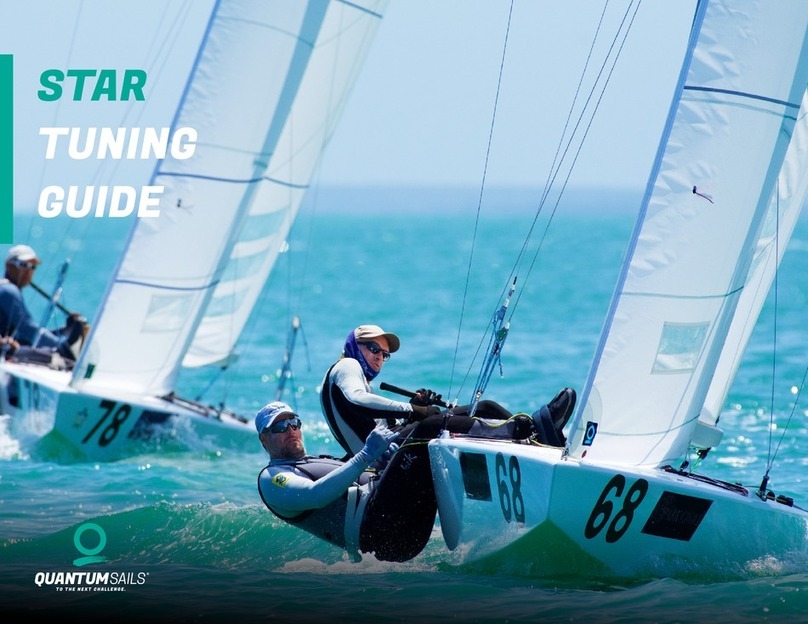
SNIPE / TUNING GUIDE
If you get the pre-bend to the right measurement and the shrouds are
tight, then your mast may be too stiff. To remedy, set the mast within the
prescribed rake range but with less shroud tension; 19 units is perfect
for achieving sufficient pre-bend. This will make the mast straighter at
the dock. With less pre-bend, more mast fore puller must be used in the
light air range.
STEP 4:
WIND RANGE STEPS – U.S. TUNING
Follow these guidelines to make changing rig tune easy, so that your
boat can maintain speed and power through the range of conditions.
A single rig tune, though easy, will not suffice for all wind conditions.
Depending on your mast, you will find the need for two or three mast
tune steps to get from light to heavy air. After you have developed a
starting light/moderate air setting, you can develop your medium air
(15-18 knots) tuning by tightening your shrouds a half hole for Holt-Allen
adjusters or 1.5 turns on the STA Masters and keeping your jib halyard
at the same mark. Re-check Steps 2 and 3 to note the changes. This will
increase your shroud tension, pre-bend, and mast rake, all good things
to have when the wind increases. When the wind is over 15-18 knots, you
may want to move your shrouds aft one hole (.75” (2cm). Use the same
halyard mark for every rig setting.
A helpful rule to determine when to change your shroud tension is to
watch the angle of your leeward STA Masters and the sag between
the forestay and jib stay at the bottom jib telltale. If the STA Masters is
leaning over more than 20 degrees (the angle your middle and index
finger make when making the peace sign) or if you can fit more than
three finger widths between your jibstay and forestay at the bottom
telltale (forestay shock cord pulled to same pin as jibstay), you should
tighten your shrouds.
STEP 2:
MAST RAKE & DECK CROWN
The wire in the jib luff bears the entire mast load while sailing. By
adjusting the jib halyard with the pullers off, changes are made to the
mast rake, pre-bend, and rig tension. With the jib up, take the tape
measure to the stern and measure the rake. Adjust the jib halyard until
you are within a range of 21’6”-21’ 7” (653cm-658cm). This will be your
upwind halyard setting. Keep in mind that the farther forward you rake
your mast, the shorter your spreaders need to be.
Hold a straight edge from one transom corner to the other and mark this
line in the middle of the stern. From this line to the top of the deck, the
Persson measures 1.75” (4.5cm). If your boat measures less, you will
have to add the difference to your rake number. If it measures more, you
will have to subtract the difference to get your rake number.
STEP 3:
PRE-BEND/RIG TENSION
Assuming that your mast pullers are off, the jib luff wire should be
loading against the shrouds and the middle of the mast will bend
forward. This is called pre-bend. It is one of the most critical aspects of
boat performance. Check that the mast is floating freely in the partners
before moving on. After the mast rake is set and the mast is floating
and the jib wire is tensioned, hold the main halyard so it is just touching
the back side of the spreader bracket. If set correctly, the bottom of the
halyard at the top of the black band should be within 1/4” of the front of
the mast.
• If there is too much pre-bend (halyard is forward of mast), ease
the shrouds and re-measure the rake. It should be 21’6”-21’ 7”
(653cm-658cm).
• If there is too little pre-bend, tighten the shrouds and re-measure
the rake.
• Using a Loos Tension Gauge will allow you to check the pressure
on your shrouds and keep them even. The base shroud tension is
20-21 units on the PT-1 Loos gauge.




























